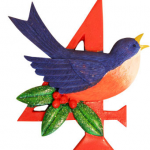 Day 4. What gift was delivered on 28th December? Thinking about possible answers to this question should help you to identify the theme’s of today’s post, so perhaps I’ll stop writing now!
Day 4. What gift was delivered on 28th December? Thinking about possible answers to this question should help you to identify the theme’s of today’s post, so perhaps I’ll stop writing now!
Some people say that the first day of Christmas is 25th Dec; leading to a 4th Day of 28th Dec and a 12th Day of 5th January. That’s the convention I’ve followed in this blog, but others would argue that the first day of Christmas is 26th Day, leading to a 3rd Day of 28th December and a 12th Day or 6th January. I wouldn’t like to say which of these is ‘right’ – it depends on your culture. So the question as asked is ambiguous – are you being asked about the gift delivered on the 3rd or 4th Day of Christmas?
Ambiguous questions cause huge problems for assessment of all types – on one of the tutor forums I look at, there has just been a discussion about one of those ‘man on ladder’ type of statics questions that physicists of my generation answered until they came out of our ears, back when we were doing A levels. But I don’t think they are so common now, and many Open University students have not done A levels. So we shouldn’t be too surprised that, when asked to draw a man 1 metre from the bottom of the ladder, some students draw the man 1 metre in front of the ladder, not on it. The immediate tutor and module team reaction is to laugh and say ‘stupid students’ but that’s not really fair. Unless the question specifies that the man is on the ladder then what the students have done is – to them – perfectly reasonable. It is important to try to anticipate and remove potential ambiguity in assessment questions of any sort (double negatives are especially tricky) but even more so in eAssessment questions, where there is not a tutor who can be asked to mark in a different way when the ambiguity has come to light.
Let’s assume now that we’ve reworded the question given at the top of this post, so that it is no longer ambiguous. Perhaps it now asks ‘What gift was delivered on the 4th Day of Christmas?’ Now we have to assume that you know the rhyme ‘The twelve days of Christmas’ – and that depends on your cultural background too. But for sense of argument, I will assume that you know the rhyme. Unfortunately, there are still a fair few ‘correct’ answers: Is is ‘Four colly birds’ (where ‘colly’, meaning a [black]bird, is sometimes spelt ‘colley’ and sometimes ‘collie’) or ‘Four calling birds’ or ”Four corley birds’ or Four curley birds’ or ‘Four canary birds’ or ‘Four coloured birds’ ? (which, according to Wikipedia are all wordings that have been used in some version of the song). So, all would need to be accepted as a correct answer. Also, if a multiple choice question asked ‘What gift was delivered on the 4th Day of Christmas?’ and only one of the above options was offered, then more able students might suspect a trick – more on that in the next post.
For now, the general points are (i) word your questions unambiguously and (ii) accept all equivalent answers. It is also important to check your questions carefully, because others (including your students) may interpret wordings differently, or answer questions in a different way. More on that later!
